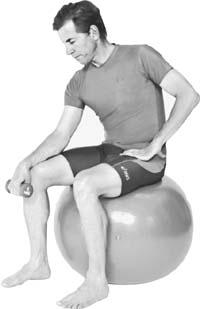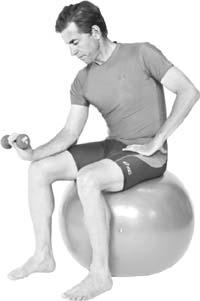Muscle Medicine: The Revolutionary Approach to Maintaining, Strengthening, and Repairing Your Muscles and Joints (26 page)
Authors: Rob Destefano,Joseph Hooper
Tags: #Health & Fitness, #General, #Pain Management, #Healing, #Non-Fiction

ANTERIOR (PALM SIDE) OF THE FOREARM
Purpose:
To bring the flexor group through its painfree range of motion. This will warm up the muscles and help relieve tension.
Starting out:
Sit on a stability ball or chair with your feet spread shoulders’ width apart. The treatment arm should be bent at the elbow with the hand palm up and in a neutral position. Your opposite hand should be holding the treatment hand with the fingers across the treatment fingers.

How to do it:
Straighten your arm, then use the opposite hand to gently bring the fingers of the treatment hand back toward the body. Keep the motion slow and controlled. Hold for a count of two. Repeat with your other arm. Do ten repetitions, held for no more than two seconds each.
Troubleshooting:
Don’t pull on the muscles of the hand—you should feel no more than a gentle stretch. Less is more! Make sure the elbow is straight before extending the fingers.

POSTERIOR (KNUCKLE SIDE) OF THE FOREARM
Purpose:
To stretch the extensor group. This will help increase flexibility and prevent injury and tightness.
Starting out:
While standing with your arm straight at your side, flex your wrist, stretching the muscles on the posterior side of the wrist.

How to do it:
With the wrist still flexed, turn your fingers away from your body to feel the stretch in the extensor muscles of the forearm. Repeat with your other wrist.
Troubleshoot:
Make sure to keep your wrist flexed and your elbow straight and locked throughout the stretch.

ANTERIOR (PALM SIDE) OF THE FOREARM
Purpose:
Wrist curls, to strengthen the flexor group. This will warm up the muscles and help prevent strain on the structures of the wrist and forearm.
Starting out:
Sit on a stability ball or chair with your feet spread shoulders’ width apart. The treatment elbow should rest on the knee, with the palm facing up and the wrist extended. A hand weight should be held loosely.

How to do it:
Grip the weight and curl it up toward your body, without taking the forearm off the leg. This isolates the target muscles. Hold for a count of two. Repeat with your other arm. Do ten repetitions, held for no more than two seconds each.
Troubleshooting:
Make sure the rest of your body stays relaxed—keep the movement restricted to the forearm. Don’t let the shoulders ride up and don’t lift the forearm off the leg.

POSTERIOR (KNUCKLE SIDE) OF THE FOREARM
Purpose:
Wrist extension, to strengthen the extensor group. This will warm up the muscles and help prevent strain on the structures of the forearm.
Starting out:
Sit on a stability ball or chair with your feet spread shoulders’ width apart. The treatment elbow should rest on the leg, with the palm facing down and the wrist flexed. A hand weight should be held loosely.

How to do it:
Grip the weight and bring it up and toward the body by pulling the wrist back. Keep your forearm on the leg throughout the movement. Hold for a count of two. Repeat with your other arm. Do ten repetitions, held for no more than two seconds each.
Troubleshooting:
Make sure the rest of your body stays relaxed—keep the movement restricted to the forearm. Don’t let the shoulders ride up and don’t lift the forearm off the leg.


THE LOWER BACK
